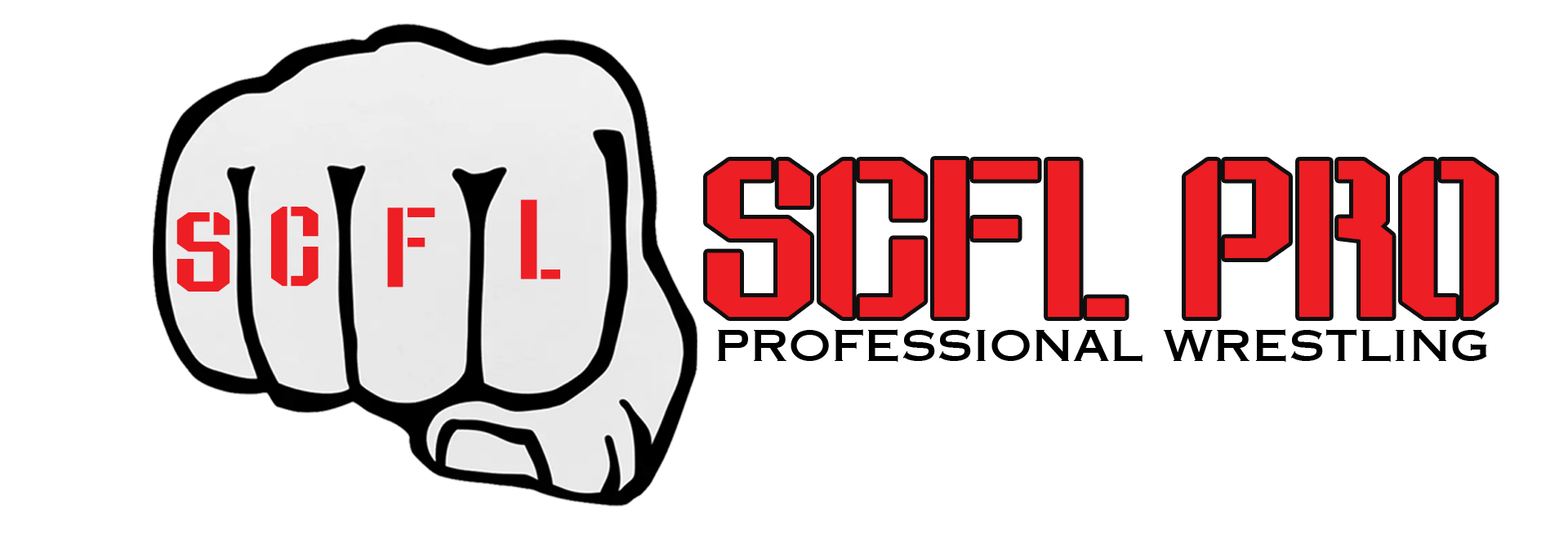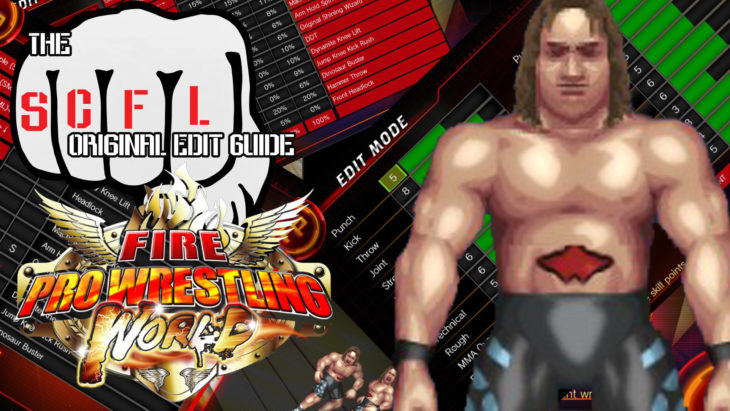
GUIDE: Creating Your Own Original Fire Pro Wrestling World Character
Note: This is not inherently related to SCFL Pro, although the techniques are absolutely utilized in the creation of characters of SCFL Pro in Fire Pro Wrestling World.
UPDATE: You can download Bike Bianchi from the PS4 Workshop now as a guide. To look him over, download him, move from retired into an active group, then choose “new edit” and use model, select Bike and you’re off.
With the release of Fire Pro Wrestling World for PS4 there will absolutely be an influx of newer fans that don’t have the experience in creating edits (what other games call CAWs), especially original ones, not based entirely off of real world wrestlers or personalities. There will also be fans of the series that may have not delved into original character creation or need a refresher. If you fall into any of the above categories than this guide will hopefully be able to help you in what is an overwhelming and obtuse character creation system for the first time.
Appearance
I’m not really going to go into crazy detail here because that, along with setting of a name, nickname, etc. are fairly straight-forward. The appearance editor may take some time to get used to, but Fire Pro Wrestling World is the most powerful version of Fire Pro Wrestling to date, which means congratulations, you’ve got more options than most of us could ever imagine in the series prior.
Play around with the layering system, change the highlight percentage to make something look flat or matte, or make it really shine and reflect light. Just try not to use pure black or pure white colors because they tend to look a bit strange in the actual game itself. Don’t forget to copy and paste colors as you go. Oh yeah, and filter under “gender unknown” for those skull caps for use with the older heads from previous games that have gaps where the hair part usually goes. Remember that this is all about your creativity here and what you can do with the edit system. Want to make a character with a mohawk but a buzzcut underneath? You can do that. Want a character with facial scars? You can do that. The sky is really the limit here.
Skill Edit
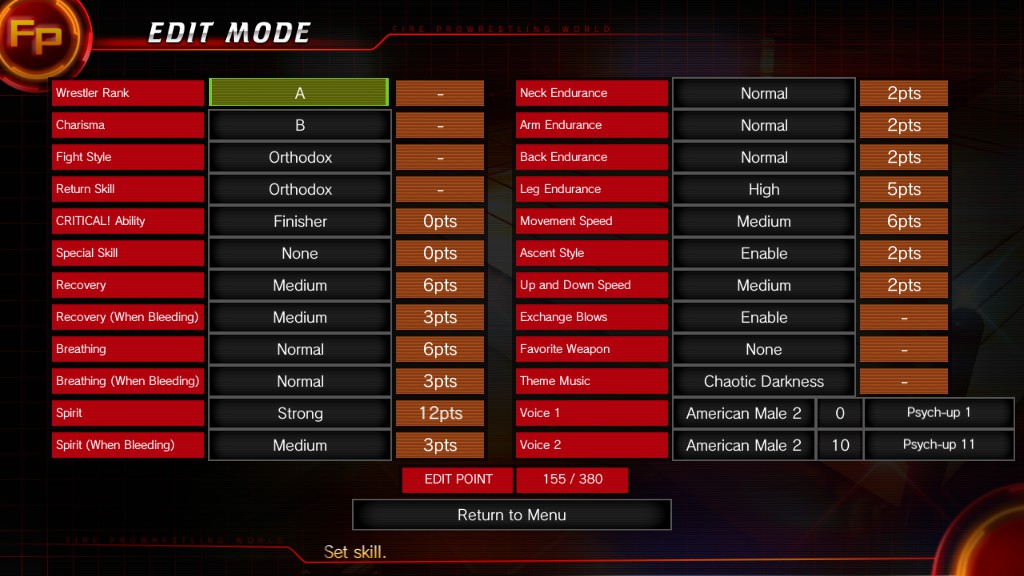
Welcome to Fire Pro Wrestling World, because this is definitely the first place where players are going to hit a snag. I’m using Bike Bianchi as the standard here, so all of these stats are from his base character that we use during our live events. Wrestler Rank and Charisma are fairly straightforward, although that’s for what they are, not what they do. It uses an S to E ranking system for both their “rank” and how charismatic they are. S is for a legend, E is for a jobber. What exactly do these do? The higher the rank and charisma, the more excited the crowd is in watching them wrestle, with them more likely to have higher-rated matches. It’s still not exactly clear which one matters more, to be honest.
Next are your fight and return styles. While these might seem fairly straightforward, they sort of aren’t. LordMo put together a rather in-depth guide as to the move affinities, reversal types and everything else you could want to know about this, but honestly, it’s a bit complicated and not all information you need right now. What the fight style impacts the most is the following: move affinity, jump distance, rope running, etc. Orthodox doesn’t mean that a wrestler is more “normal” or whatever, it means that it’s an all-around style. Moves are ranked in a similar A to E fashion, with that impacting how gassed your wrestler gets while executing the move. Try to use common sense here when picking a style.
Personally, I don’t ever drift far from Orthodox, Technician, Junior, Power, Heel and a few others. Orthodox is an all-arounder, while Technician is more in the vein of a Bret Hart-type character that has a clear strength at stuff like stretches, technical pins and some high-flying. Most are fairly straight-forward, while others like “Mysterious,” “Panther” or “Vicious” aren’t. Those specific styles were created with certain wrestlers in mind: Great Muta for Mysterious, Tiger Mask for Panther and Antonio Inoki for Vicious. There’s definitely a rabbit hole to go down here, but the basics won’t steer you wrong, nor should you really worry much about move affinities at this point.
Return styles are similar, but mostly impact the reversals that your character will do. I’ll at times get creative here, but pairing fight and return style up is a fair bet, usually. In this case, Bike Bianchi, who is a fighter who favors knee strikes, kicks, high-flying moves and a few high-impact slams is a straight-orthodox fighter. He’ll do a few roll-ups as reversals, no move will really gas him out more than others, he’s not going to do really fancy reversals like you’d see from a Junior or really dickish ones like in Heel, etc.
CRITICAL! ability is how your character and knock out other characters. The default is finisher and your best bet. That means that your finisher has a small chance to knock someone else out when it’s executed. There are factors at play as to how likely it is, but it’s rare as it is. These are also fairly straightforward in what they do, but most characters won’t be using much beyond finisher. Jason Blackhart (one of the gods of the Fire Pro community) has a guide from Fire Pro Returns that details which moves can critical under what conditions. Sometimes it’s not as important as you’d wish. Like, for example, a suplex critical style sounds cool until you realize it takes up a lot of points and that there’s only a small handful of moves that are assigned to critical under suplex style. Submission style is only for MMA-style submission holds, not for stuff like Dragon Sleepers or Sharpshooters.
Special skills are another area that is rather detailed. Denizen and Carlzilla have their own original edit guide with details on these in there. In most cases, these take up a lot of points and are kind of advanced. Your average character won’t need them at all and most of the Fire Pro defaults in past games didn’t use them at all, only a few legends would. Stardom is a good bet for an American-style character who taunts a lot and hits a lot of signature moves. Finisher is good for giving your specials and finishers a boost, helping them to be more effective at finishing matches, guts is good for a character to refuse to tap out to submissions and hardbody is good for an edit that kicks out more often. These are worth investigating further down the line, but like I said, most characters don’t need them. As you can see, Bike has none and he’s one of our top stars.
Now we’re into some more straightforward stuff. Recovery, Breathing and Spirit. Each one has two different attributes, one for normal and one for bleeding. Recovery is how quickly a character will recover from taking a move, breathing is how much of a breath meter the character starts out with and spirit is a meter for how likely a character is to kick out of moves and continue fighting. As you can see for Bike, he’s a medium/normal guy across the board, except for spirit where he’s strong. That means he’s more likely to have longer matches than someone with normal or low.
The body part endurances are something you should be able to figure out on your own. I hope.
Movement speed is exactly what it sounds like, ascent style means if your character can climb the ropes or do running rebound moves, up and down speed is… yeah, exchange blows is if your character can get pulled into a strike exchange and favorite weapon lets you choose which weapon they’re likely to pull out from under the ring.
There’s an edit point total at the bottom of the screen and as you can see, we’re not crazy about high point totals. Bike, one of our main event pillars, has 155 paltry points. You’ll find this is more-or-less in line with how Spike makes their own characters as well. Keep point totals in mind and if you’re creating, say, your own league full of original characters, come up with a point structure that works for you. Have clear tiers of characters, but remember that points aren’t everything, that CPU logic has a lot to do with how a character performs.
Parameter Edit
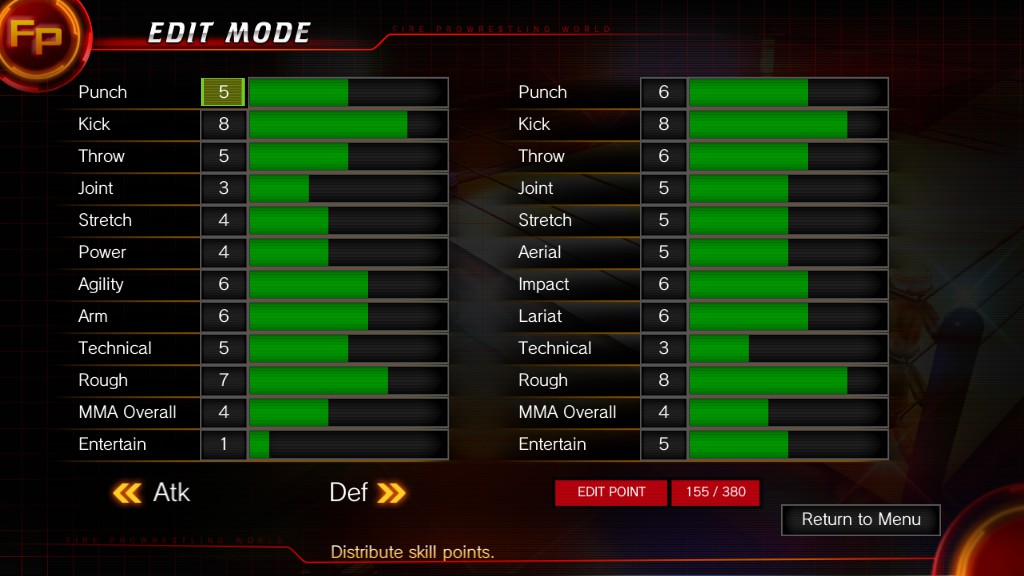
This it the other place where your character will be assigned points that go towards their total. Each attribute has a 1-10 scale, 1 being the worst, 10 being the best. Honestly, I don’t use 10’s all-that-often. Bike is an incredibly skilled kickboxer who favors kicks and knees, but his kick stats are at 8. Think of it this way: your character has a health bar and the attribute here plus the moves base damage and any modifiers (such as Finisher special skill) are the damage that is subtracted from an opponent when they take a move. The defensive stat is how resilient they are to that move. So if Bike takes a kick move that, for example, does 15 damage, but Bike has an 8 in kick defense, he’s able to cut into how much damage that move does to him. I’d always recommend higher defense stats and lower offense stats to create longer matches (if that’s what you’re looking for). Every move uses two stats, sometimes it lists the same stat twice, like if a move is a pure kick then it’ll be KICK/KICK, but most moves, like grapple knees, use two, so KICK/ROUGH.
Move Edit
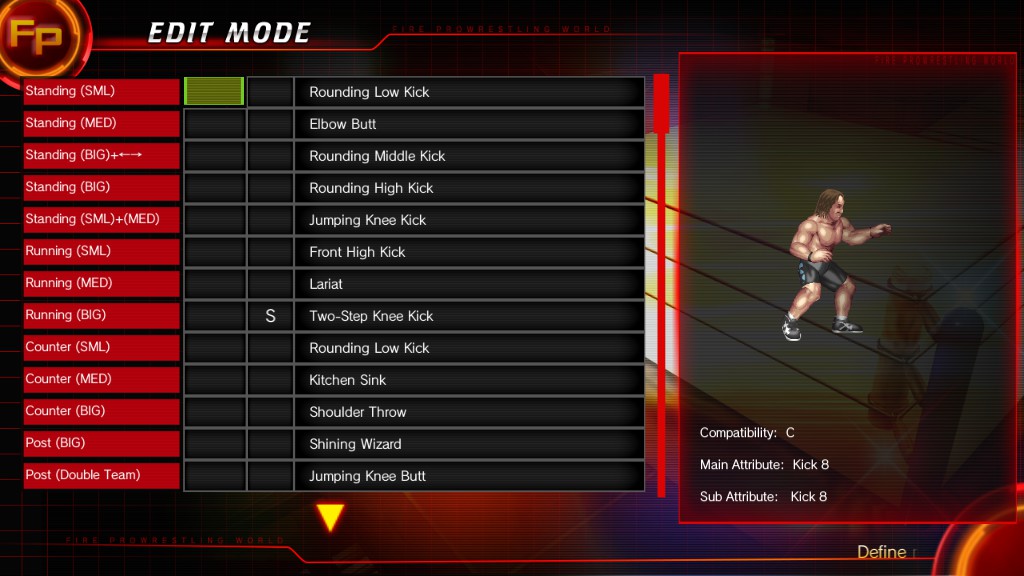
Here is where most people will spend most of their time getting lost in Fire Pro Wrestling World’s edit suite: move edit. Assigning moves is perhaps the coolest part outside of appearance. My advice here is to be careful. Once again using Bike as an example, you can see that I tend to be a bit moderate in assigning moves. The reason for that is that your first instinct will always be to load up a character with really cool, big moves. The reality, though? The reality is that most wrestlers don’t do nothing but crazy, big moves. Bike has a low kick, middle kick and high kick, as well as an elbow strike and finally a jumping knee.
Try to imagine how a wrestler with a similar style acts in the ring and the moves that they do. Take, for example, a Ric Flair. For Flair you’d use a weak punch, a toe kick, a chop, a dropkick and perhaps a “stronger” punch like the American Hook. That stands to reason for most of this whole section. Think about how a real wrestler works and try to have their moveset build momentum.
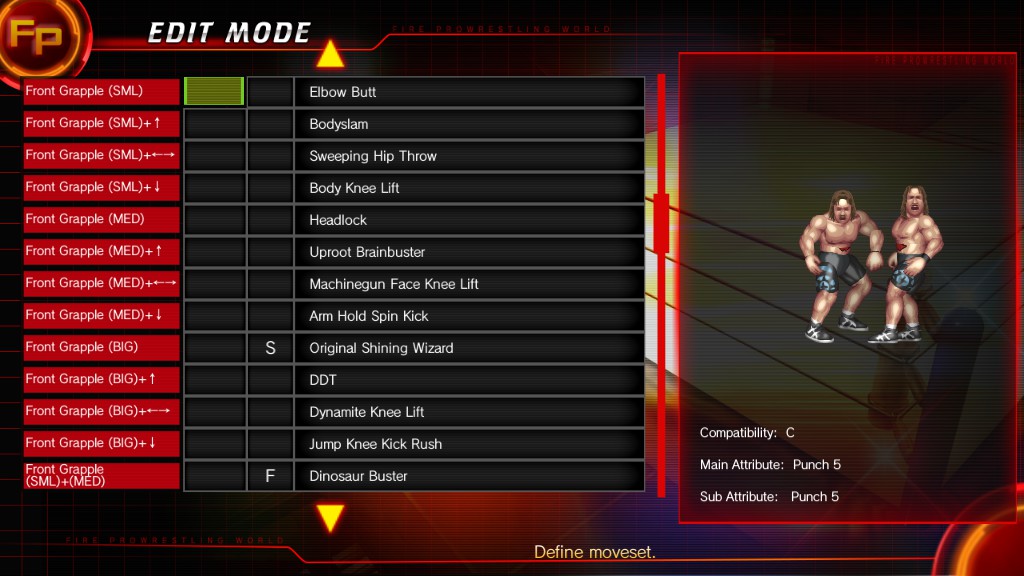
There are a few “best practices” that allow for easier playability and to keep you sane when your roster starts expanding, which is to follow this pattern for grapples:
X: Strike or hold
X ^: Slam/Suplex
X < >: Strike or suplex
X v: Strike or impact move, like a DDT, piledriver, etc.
That’s just for medium grapple. You can look at Bike’s moveset above for an example. This, loosely, follows how Spike and previously Human created characters. Weak and up is always a bodyslam, medium and up is always a suplex, etc. In strong grapple you get one extra move slot, which is a good place to put a very specific kind of move. Weak and medium moves leave your opponent on the ground for a short period of time. Stronger grapples have longer-lasting effects, obviously. Everything except for sml+med have the ability to have an opponent stand up groggy for a moment, while sml+med will leave the opponent on the ground for longer. So, in the case of Bike, none of his moves outside of his finisher lead to a pinfall or submission, which means that they all have the ability to put the opponent down on the ground, then stand up groggy, setting them up for a standing attack, a go-behind, a running attack or a top rope/slingshot attack.
So, if you have a character that does a lot of back grapples, like german suplexes or chokes, you’ll want at least a move or two that leaves an opponent groggy. For the sml+med slot you’ll want to save that for a move that’ll leave your opponent on the ground for longer to set up a flying move, such as a splash or elbow drop. In the case of Bike, he doesn’t really do flying moves to downed opponents that often, but he does do a flying knee strike to a groggy opponent on top of a running knee strike special, so he has many moves to leave his opponents groggy and his one pinning grapple is set to the sml+med slot. Remember that priority chains, which I’ll cover later, do have the ability to do some cool stuff, but keep this basic idea in mind for now about groggy or staying down longer.
CPU Logic: Fire Pro Wrestling World’s Secret Weapon
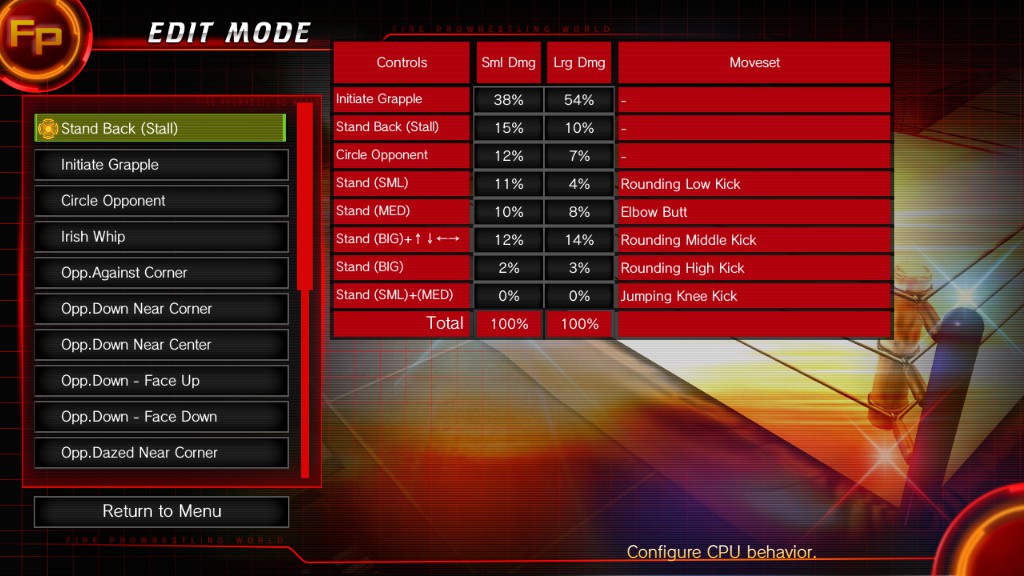
Want to know why SCFL Pro uses Fire Pro Wrestling World instead of any other wrestling game? CPU logic. Now, look, I’ve been playing Fire Pro games for over twenty years now and really getting into the nuts and bolts of CPU logic for at least 15 of those, if not more. I have penned guides like this previously and ran a somewhat competitive e-fed for years where we all worked together in forging logic rules and what have you.
CPU logic is going to really rely on what you want and will require experimentation. Do not, for the love of god, clone Spike official edits for an idea of how to do CPU logic. They are built to be played against, which means they are trying to make edits that will try to win a match against you, the player, not put on an entertaining bout between two CPU opponents. This is literally the soul of your character.
Style is everything here. There is going to be a vast learning curve for this no matter what and, truthfully, I’m not going to be able to tell you everything in this guide. At a later date I may make a strictly CPU logic guide because of how complex this can be, but, for now, we’ll cover the basics. Above you can see Bike’s standing logic. He’s a striker so he’s more prone to throwing a strike than entering into a grapple. When he does grapple, how does it look? Well…
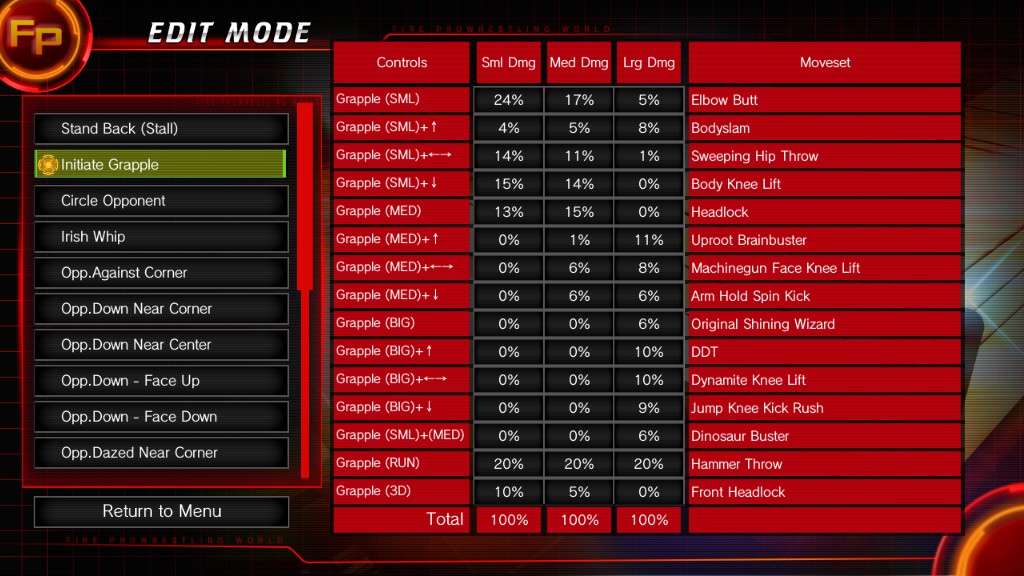
I’m either fairly radical or conservative, depending on how you view Fire Pro edit-making. A lot of this has to do with personal preference. My favorite style of wrestling is a more striking-and-submission style of wrestling a la 90’s New Japan Pro Wrestling or even early 90’s All Japan Pro Wrestling before they went nuts with the head drops. I firmly believe in applying a ton of logic to small grapple strikes and simple throws early on and never really let up on those while keeping the logic on bigger moves later on in the match relatively low. Bike’s finisher at large damage is only set to 6%, for example. That means that 6% of the time that he locks up into a front grapple he’ll attempt the Dinosaur Buster. Sort of. The random number generator that the game uses can sometimes make things happen more or less, depending on the situation.
At large damage I like to keep most of my points spread among the weak and medium moves, which are the heart of the match, while the bigger moves are used sparingly. This perhaps doesn’t jive with some modern wrestling, like, for example, your average Kenny Omega or Kota Ibushi match, but this idea of conservative logic on bigger moves came from years of watching characters do nothing but crazy moves for most of the match. Also take into account that bigger moves do more damage and shorten the match. You’ll also want to remove any possible weardown submissions from large damage to avoid the dreaded headlock or abdominal stretch finish (unless that’s what you’re going for). This headlock that Bike has can’t submit, but it’s good form to get rid of it anyway. The front headlock is valuable for making a character drag their opponent towards the center of the ring, which is good for corner-to-center moves and running to downed moves.
Take this idea of moderation throughout the logic section. You’ll thank me for it later.
Ukemi is probably the weirdest, more recent (as of Fire Pro Returns) addition to the series, in that it allows your character to forgo the usual auto-reversal that is bound to happen early on in the match or randomly, according to the RNG later on, to “bank” spirit to be used later on in the match. There’s debate if this does a lot or a little, but think of it this way: pro wrestling is a cooperative thing, where two wrestlers will have to agree to take a move from the other. What this setting does is makes a character more prone to taking a move at a specific point in the match without the luxury of reversing it. For Bike I have him at 30/30/15, which makes him a babyface that will take less flak near the end of the match and [hopefully] come back against a heel or someone beating him down for most of the match. This stat doesn’t make your character take, for example, 30% more moves than usual, but it does come into play and the spirit boost can be cool for some fun, late-match moments.
Priority logic is another, fairly new concept to the Fire Pro series, introduced in Returns. What this does is allows you to chain moves together. Cool, right? In Fire Pro Wrestling World Spike expanded the scope and slots for this to twelve, while adding in waaaay more move positions to chain moves into. In Returns you could only chain a move into a ground move, like a pin, strike or submission on a downed opponent. In Fire Pro Wrestling World you can chain moves to taunts, running moves, top rope moves, downed moves, downed running moves, etc. You can’t chain to grapples, which is a bummer, but maybe some day?
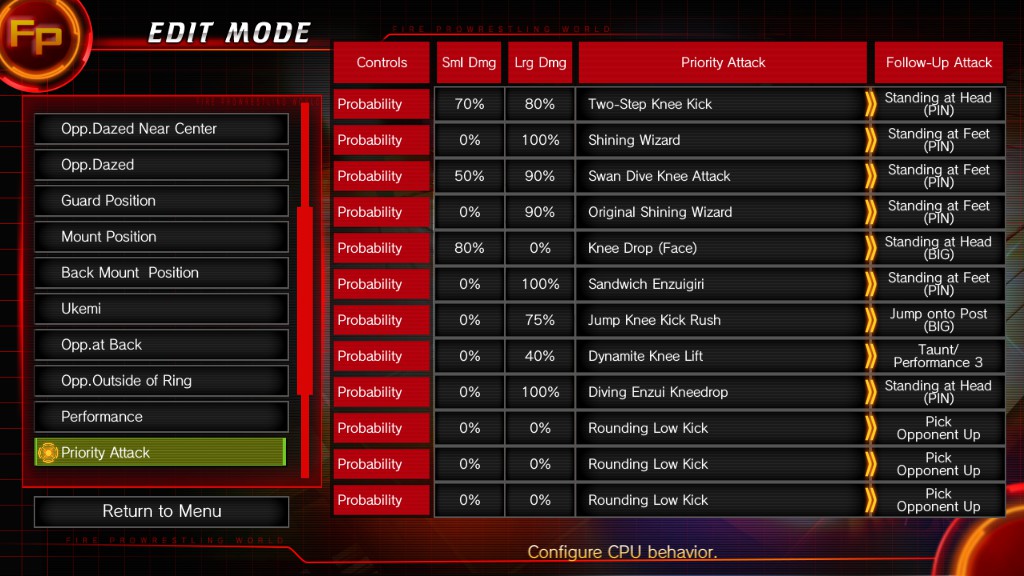
Bike’s priority logic is pretty full of stuff, so let’s delve into it. A good deal of these are moves into pins. So he’ll go for pins after some of his specials, most of which are flying knees or Shining Wizards. This is fairly straightforward and what you’ll most likely be using these for. Depending on the move you should probably have the logic pretty high on this. As you can see, I tend to be about 80-100% on these, depending on the rarity of the move. The rarer a move, the higher the logic I’ll assign to it being followed up with a pin. Bike doesn’t do that corner-to-center Shining Wizard often, so I want him to ALWAYS pins after he does it, but he does the two-step knee kick a lot so he shouldn’t always pin afterwards.
A lot of your character’s personality will come out through here. For example, Bike follows up the Dynamite Knee Lift with a taunt 40% of the time late-match. A guy like Wigwamm Watanabe has his taunts chained together so he’ll keep pointing at his head, then flipping his opponent off and go into a loop there. That’s also his character, he’s a dick who doesn’t take his matches seriously and tends to get into trouble because of how cocky he is. The jumping knee kick rush he has as a strong grapple I have set to 75% do a top rope diving knee strike. I tend to err towards higher logic for a chain into a diving move because it only triggers the priority if the character is near the turnbuckles and can land the move safely. So if Bike is out of range, he’ll either let them get up groggy or he’ll do a ground move to them.
There’s one other sort of cool thing in there, if you look, he has at head (big) to follow up a knee drop to the face set to 80% at small damage, 0% at high. What this means is that he’ll follow up the knee drop to the face with ANOTHER knee drop to the face 80% of the time, thus chaining them together, sometimes hitting it multiple times. You can do a lot like this, like a snapmare into a kick to the spine, an armdrag into an armlock and more.
You can get fancy with your chains, too. Think of The Rock’s People’s Elbow. Your chain would be as follows: Spinebuster to People’s Elbow Taunt. People’s Elbow Taunt to running downed elbow drop. Elbow drop to pin. That’s the entire People’s Elbow sequence. Now, if it works depends on how hurt the opponent is and if you can get all of that off before they get up isn’t a given. But you get the idea.
The last parts of the CPU logic were at one time sort of mystical and misunderstood, but now sort of plainly stated in the manual for this game. So I’ll give a brief idea of what they do.
Showmanship: How often your character will throw their opponent into the corners, out of the ring, onto the apron, etc.
Discretion: How often your character will stop to take a breath. The lower the stat, the more likely they are to be aggressive and perhaps gas out later on in the match. Also more likely to take risks like dives.
Flexibility: A very, very specific thing to where if your character will adjust against MMA-style edits and NOT try to irish whip them. Why? Because you can’t irish whip shooter return style characters. The higher the less likely they are to make that mistake and will use the headlock/elbow move instead.
Cooperation: For tag teams this is everything. It means how likely your character is to go for double team moves with their partner.
Outside Return Count: The lower it is, the more they’ll brawl on the outside, the higher, the quicker they will return to the ring when dumped outside. A more “hardcore” wrestler will try to brawl more, obviously, so a lower percentage.
Touchwork: The other tag team stat, this is how often your character will tag out. The higher the more tags, the lower the more “greedy” they’ll be and stay in the ring. This stat relies on which character is the healthiest, as well. So if the legal character is still in better shape than the character on the apron, they’re less likely to tag.
Weapon Usage: How often your character will try to pick up a weapon. The higher the more likely they are, the lower the less likely. You don’t have to set this super high, because think of it this way: in a deathmatch where there are weapons strewn about if a character has 50%, they’re 50% likely to pick up a weapon if they’re just standing there and not in a grapple. 50%. That’s insane. It also means they’ll dig under the ring a lot if they’re on the outside. Most faces will be lower, heels a bit higher and when I say a bit, I mean a bit. 10% is probably fine in most cases. I tend to err higher for deathmatch specific characters, but I’m talking like 25% here, which may even be high.
Second Interference: How likely your character is to distract the referee or toss a weapon into the ring to help out the character that they’re accompanying. Think classic managers like Jimmy Hart or Jim Cornette here. Good for heels, obviously. Go pretty high on this if you want to see someone involved in a match, like 70% or so.
Enjoy Fire Pro Wrestling World
Sheesh, that went long, didn’t it?
The short way to sum this up is to have fun, experiment and download edits from other creators and look at those. SCFL Pro edits are available on the Steam Workshop for you to inspect and there will be a few, including Bike Bianchi, ported over to Fire Pro Wrestling World on PS4 after its release, so look for that and use him as a guide.
Once you get into a groove, use your own characters for a base to create other characters. You do that by loading your character, editing it, and choosing “save” instead of overwrite. Then choose “new” and place them where they belong. What this does is give you a template to work off of featuring a base point value, logic settings and move set that you can work off of.
Making your own, original characters in Fire Pro Wrestling World should be fun. Remember that. Build them to your style, test sim them against each other and find what works best for you. If you like high fliers, make high fliers and have them do a ton of top rope moves. If you like bruisers, make characters that go for lariats and powerbombs galore.
You can check out Critical Club! for more Fire Pro Wrestling World guides and other information at any time.
NOTE: We use Amazon Affiliate codes. Any purchases made through it we receive a small portion of.
